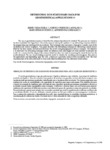Please use this identifier to cite or link to this item:
http://www.alice.cnptia.embrapa.br/alice/handle/doc/886765| Title: | Detrending non stationary data for geostatistical applications. |
| Authors: | VIEIRA, S. R.  CARVALHO, J. R. P. de   CEDDIA, M. C.   PAZ GONZÁLEZ   |
| Affiliation: | SIDNEY ROSA VIEIRA, IAC; JOSE RUY PORTO DE CARVALHO, CNPTIA; MARCOS BACIS CEDDIA, UFRRJ; ANTONIO PAZ GONZÁLEZ, Universidade da Coruña, Espanha. |
| Date Issued: | 2010 |
| Citation: | Bragantia, Campinas, v. 69, p.1-8, 2010. |
| Description: | The use of geostatistics requires at least that the intrinsic hypothesis be satisfied. The presence of a trend in the data invalidates this hypothesis. One of the ways of solving this problem is by subtracting a function fitted to the original data and working with the residuals. This technique also represents a change to a smaller scale of the variability and surface roughness. This paper describes the detrending technique of subtracting a trend surface fitted by the least squares method and discusses the results using topographical data as examples. The objective is to show how the detrending technique works for different scales and degrees of trend and how to interpret the results. It is shown that the simplest the surfaces fitted that does the work of removing the trend the best are the results obtained. The use of jack knifing is proved useful to validate the resulting semivariograms. For most of the applications and depending upon the scale, a linear or a parabolic surface works reasonably well. The back transformation of the data afterwards is very easily done by adding back the subtracted trend surface. |
| Thesagro: | Topografia |
| Keywords: | Erro reduzido Estacionaridade Variação de escala Scale of variation Stationarity Semivariograms |
| Type of Material: | Artigo de periódico |
| Access: | openAccess |
| Appears in Collections: | Artigo em periódico indexado (CNPTIA)  |
Files in This Item:
| File | Description | Size | Format | |
|---|---|---|---|---|
| Detrending.pdf | 3,17 MB | Adobe PDF |  View/Open |









